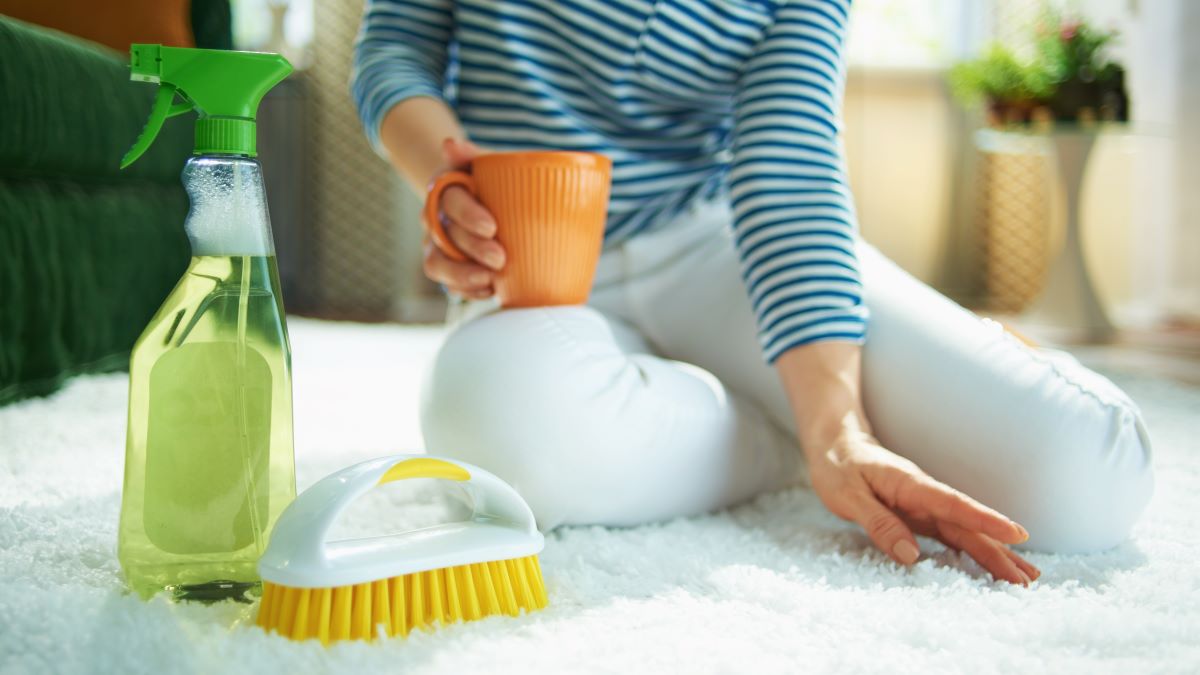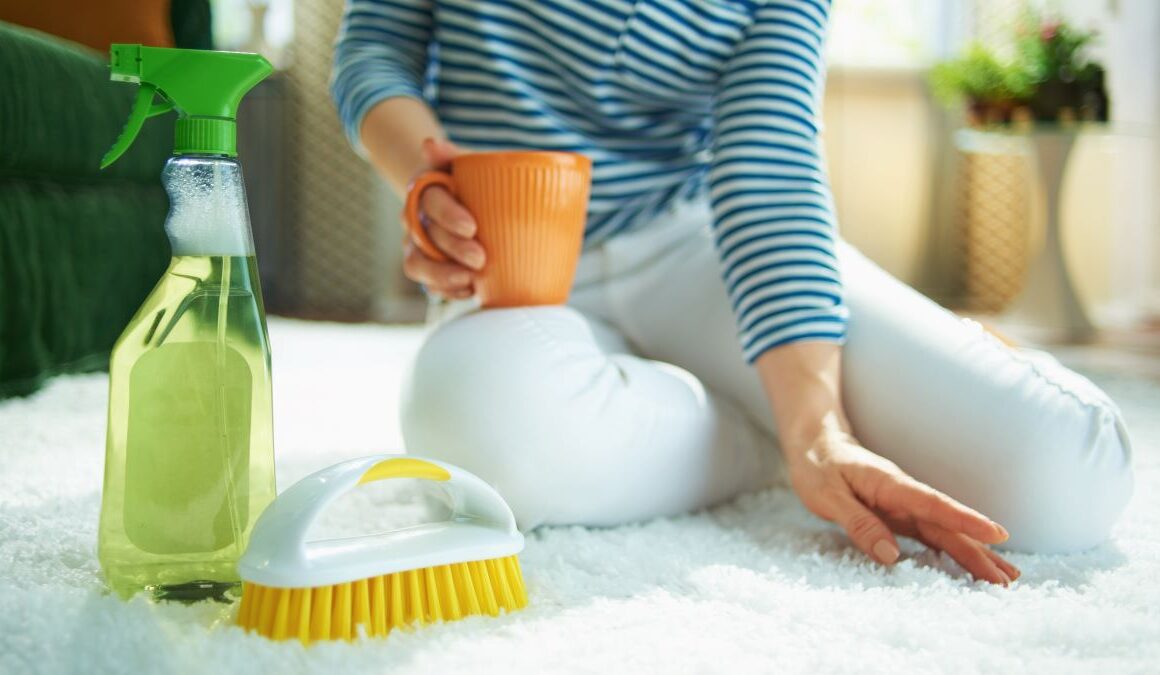Better Carpet and Upholstery Cleaners

Having fresh, stain-free carpeting, area rugs, and furniture enhances the aesthetics of the room, creating an inviting atmosphere. And although it seems like this would also promote a healthier living environment by reducing allergens and dust buildup, there are other factors to consider. Hazardous chemicals commonly lurk in carpet and upholstery cleaning products and do not readily rinse out, but there are some healthier and more natural alternatives.
This article contains affiliate links. If you purchase an item through one of these links, we receive a small commission that helps fund our Recycling Directory.
Concerning Chemicals in Carpet and Upholstery Cleaning Products
There are numerous hazardous chemicals to avoid to reduce toxins in the home.
- Perchloroethylene (or perc, tetrachloroethylene, or tetrachloroethene) is in many “dry” carpet cleaner products and is toxic in high amounts, especially when inhaled. It can irritate the eye, nose, and respiratory issues, and long-term exposure may increase the risk of certain types of cancer.
- Acrylic acid is highly toxic to aquatic life, and inhaling it can irritate the nose, throat, and lungs. It is also found in various household cleaners, including some RESOLVE carpet cleaning products and many commercial toilet and oven cleaners.
- Surfactants are harmful to human health and aquatic life. They are used in many conventional cleaning products, including Shout carpet cleaners, and can biodegrade into more toxic and persistent chemicals that can bioaccumulate.
How To Find Nontoxic Carpet and Upholstery Cleaning Products
Using safer carpet and upholstery cleaners helps safeguard your your family, pets, and home from harmful chemicals.
Read Cleaning Product Labels
It can be challenging to identify safer cleaning products by reading the ingredient lists on product labels, but there are certain red flags to beware of. For example, avoid products listing fragrance, ammonia, and bleach.
Warning labels can provide helpful information. Avoid carpet and upholstery cleaners with labels stating “warning,” “danger,” or “poison.” Some bottles say to avoid contact with skin and wash hands immediately after use. However, if it says to avoid contact with skin, you probably don’t want the product on your sofa, armchairs, or rugs either.
Third-Party Information on Rug and Sofa Cleaners
The Environmental Working Group (EWG) rates carpet cleaners and fabric/upholstery cleaners to help shoppers find more natural alternatives to toxic cleaning products.
Of the carpet cleaners it rated:
- 2 scored an A
- 3 received a B
- 5 got a C
- 30 scored a D or F
Of the fabric and upholstery cleaners it rated:
- 2 scored an A
- 2 got a B
- 3 received a C
- 10 scored a D or F
While numerous commercial cleaners on the market contain harmful ingredients, there are also a few safer, nontoxic alternatives.
EWG’s Highest-Rated Carpet Cleaning Products
The following cleaners scored between an A and C.
UL Ecologo-Certified
ECOLOGO-certified cleaning products are certified by UL Solutions for reduced environmental and health impact.
EWG’s Highest-Rated Fabric and Upholstery Cleaners
The following products received a score between A and C.
DIY Homemade Carpet and Furniture Cleaners
A simple way to find natural products to clean your upholstered furniture and rugs is to make your own products with nontoxic ingredients. Using homemade cleaning products can save you money and packaging waste while offering peace of mind. Some of the best DIY carpet and upholstery cleaners contain baking soda, distilled white vinegar, and essential oils, such as lemon or lavender.
Homemade Carpet Cleaner with Baking Soda & Vinegar
This is a simple way to remove odors and naturally clean your carpeting and area rugs. The exact amount of ingredients depends on the size and number of rugs you are cleaning. You can add several drops of essential oil to the baking soda to add a scent or to help remove unpleasant odors or else make an unscented carpet cleaner.
Note: Before trying any cleaning method on your carpet, spot test in an inconspicuous area to ensure that the baking soda and vinegar do not cause discoloration or damage to the carpet fibers.
Ingredients:
- Distilled white vinegar
- Baking soda
- Essential oils (optional)
Directions:
- Begin by removing loose dirt and debris from the carpet by vacuuming it thoroughly.
- Sprinkle a generous amount of baking soda (possibly with essential oils mixed in) over the entire carpet surface. Baking soda helps to deodorize and lift stains from the carpet fibers.
- Allow the baking soda to sit on the carpet for at least 30 minutes. For tougher stains or odors, you can leave it on for an hour or even overnight.
- Prepare the vinegar solution by mixing equal parts of white vinegar and warm water in a spray bottle. For example, you can use one cup of vinegar with a cup of water.
- Spray the vinegar solution evenly over the carpet. The vinegar will react with the baking soda, creating a fizzing sound.
- Take a clean cloth or sponge and gently scrub the carpet, targeting any visible stains or high-traffic areas.
- Next, blot excess moisture with a rag. Continue blotting until most of the moisture is absorbed. This step is crucial if your home has a high humidity level when cleaning because it won’t air dry as quickly.
- Allow the carpet to air dry completely. You can improve the drying process by using fans or opening windows to increase air circulation.
- Once the carpet is dry, vacuum it again to remove any remaining baking soda residue and loosened dirt particles.
DIY Sofa Cleaner
You can follow a routine similar to the directions above for carpets to clean sofas and other upholstered furniture. However, vacuum up the baking soda mixture before applying the vinegar spray. If you want to use a scented cleaner, add several drops of essential oils to the vinegar solution, not to the baking soda.
Spot Cleaner for Carpets and Sofas
Vinegar and baking soda are also excellent for cleaning sofa, carpet, and rug stains. Spot cleaning is most effective immediately after a spill or stain occurs. The longer a stain sets, the harder it may be to remove. Also, consider if the stain is oily or not. If so, using dish soap can be helpful. Test the cleaning solution in an inconspicuous area of the sofa or rug first to ensure it doesn’t cause discoloration or damage to the fabric.
Ingredients:
- Distilled white vinegar
- Baking soda
Directions:
- When you notice a spill or stain, act quickly and blot the affected area with a rag. Avoid rubbing, as it may spread the stain further.
- If the spot is still visible, sprinkle some baking soda directly onto the stain.
- Mix equal parts of white vinegar and warm water in a spray bottle. Spray this solution onto the stained area where you’ve applied the baking soda. The vinegar will react with the baking soda, creating a foaming reaction that helps lift stains.
- Use a clean rag or sponge to gently blot and scrub the stained area. Work from the outside of the stain towards the center to avoid spreading it further. Continue blotting until the stain starts to lift.
- If needed, dampen the rag and blot the area to remove any remaining vinegar and baking soda residue.
- Allow the spot to air dry completely.
- If the stain persists, mix a small amount of mild liquid dish soap with water and apply it to the spot. Gently blot and scrub again, then rinse with water and blot dry.
Note: For more DIY carpet and fabric cleaning solutions, see 4 Natural Ways To Tackle Carpet Stains and Planet-Friendly Stain Removal Tips.
Choose Safer Carpet and Upholstery Cleaners
Although there are numerous unsafe commercial carpet and upholstery cleaning products, there are also some natural and safe cleaning products that contain nontoxic ingredients. Look for third-party certified carpet and sofa cleaners, or make your own using baking soda, white vinegar, and possibly essential oils.


